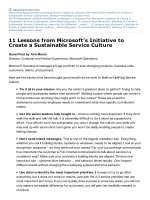Lesson NNU: Developing a Service Culture at NNU
Bạn đang xem bản rút gọn của tài liệu. Xem và tải ngay bản đầy đủ của tài liệu tại đây (884.53 KB, 31 trang )
Developing a Service Culture
at NNU
Positives--- NNU
Seasoned Leadership
Terrific Staff
Outstanding Product
Committed Constituency
More than an Education
Good Value
Desirable Location
Right Size
Why A+ Service at NNU
1.
2.
3.
4.
5.
6.
Competition.
Turns recruitment success into retention
success.
Rising expectations of our “customers.”
Improve our image.
Contributes to a pleasant work environment.
Facilitate learning.
Our students are our customers, as well as
our product. We must treat them accordingly,
in the way that you expect to be treated when
you go to make a major purchase.
Derek Hodgson, Provost – Mississippi State University
“A student does us great honor by entrusting
her or his higher education to us; they give us
their future. In return, let us be certain that we
do everything that we can to ensure that when
they leave here, they are as well prepared for
that future as we can possibly make them.”
Derek Hodgson, Provost
Mississippi State University
REMINDER
No one has to enroll at NNU
No one has to stay at NNU
Everyone want to be treated with respect and
appreciated
Studentkeeping Colleges:
Value Students – Every college or university teaches that students are
important. We’re not talking about employee manual directives, but
about the heartfelt, sincere belief that the student is the most important
person in the organization.
Are Organized Around Students – The Studentkeeping institution has
flattened the hierarchyhappy organizational chart and broken down the
thick walls between departments. It doesn’t matter how high or how
deep you are inside the institution; students are still the concern.
Are Hardwired to Serve Students – Hardwiring is the rewards system. A
studentkeeping institution’s hardwiring will reinforce attitudes and
behavior that place the students first.
Have Leaders that Point the Way – Leaders provide three critical
elements to change: permission to experiment, try new ways to fail;
protection from organizational immune systems that kill anything new;
and tools to help people create solutions.
Great service keeps customers coming
back:
Oliver, the doorman at Chicago’s
Continental Plaza, opened the taxi for a
man, greeting him, “How are you? We’ve
been waiting for you!” The man beamed –
at last people realized how important he
was. The doorman was tipped generously,
and as the man walked into the hotel, he
heard the doorman open the next taxi and
cry out, “How are you? We’ve been
waiting for you!” Tough Selling for Tough Times –
Murray and Neil Raphel
Technology and Service
“Technology is entropic; it always degrades.
The biggest problem is what I call ‘midtech’ –
the trappings of hightech, but delivering a
lowtech experience. When you check into a
hotel and have to wait in line for 45 minutes
because the computer is down, that’s mid
tech. When you call an ‘800’ number and it
just rings 20 times, that’s midtech. It drives
customers away…”
James Rosenfield
There is less to fear from
outside competition than from
inside inefficiency, uninspiring
teaching, discourtesy, and
bad service.
Special Report on Campus
Retention
*The number of faculty and administrative staff
employed is based on enrollment.
*When student enrollment is down, there is less
need for faculty and administrative staff.
*Student enrollment is down.
Can you help??????
The Key!!
The key to achieving sustainable competitive
advantage in today’s markets is to build
relationships with students by serving them in
excellent fashion…not just selling to them.
In the Service age, service is
not just something managers
should think about now and
then; it is management.
Karl Albrecht
Five General Dimensions of Service
1.
2.
3.
4.
5.
Tangibles: Appearance of physical facilities,
equipment, personnel, and communication
materials.
Reliability: Ability to perform the promised
service dependably and accurately.
Responsiveness: Willingness to help customers
and provide prompt service.
Assurance: Knowledge and courtesy of
employees and their ability to inspire trust and
confidence.
Empathy: Caring, individualized attention the firm
provides its customers.
Relative Importance of service Dimension When
Respondents Allocate 100 PointsAssurance
Reliability
32%
19%
Empathy
16%
Responsiveness
22%
Tangibles
11%
Two Levels of Expectations
Desired service
Zone
Of
Tolerance
Adequate Service
Customer – Student Service
“One of the most common mistakes I think
organizations make is that they put
responsibility for good customer service
totally on the shoulders of the frontline
employees. Good customer service does
not happen without effective management
methods, strategies, and empowerment of
employees. It’s a behindthescenes effort
that results in good frontline customer
service.”
Linda Halverson, University of St. Thomas, Minneapolis, MN
…every point of service delivery is
a time when students evaluate
whether they have gotten their
money’s worth, whether the price
they have paid equals or exceeds
the value of what they are getting
and what they were promised.
Sales and Marketing Management
Common Customer Service Problems
Complicated fee payment procedures.
Poor communication between offices.
Technology behind the times.
College’s hours and services don’t match
student needs.
Repeat same mistakes semester after
semester.
Admissions not responding to needs of
entering students.
Generic Product
Expected Product
Augmented Product
Potential Product
Good StudentCustomer
service involves…
1. Feeling positively toward student
2.
3.
4.
5.
customers.
Encouraging studentcustomer
feedback.
Responding to studentcustomer
problems.
Developing repeat relationships.
Seeking to exceed studentcustomer
expectations.
Linda Halverson, University of St. Thomas, Minneapolis, MN
Ten Commandments of Human Relations
1.
2.
3.
4.
5.
6.
7.
8.
9.
10.
Speak to People. There is nothing as nice as a cheerful
word of greeting.
Smile at People. It takes 72 muscles to frown, only 14 to
smile.
Call People by Name. The sweetest music to anyone’s ears
is the sound of his name.
Be Friendly and Helpful. If you would have friends, be
friendly.
Be Genuinely Interested in People. You can like everybody
if you try.
Be Generous with Praise. Cautious with criticism.
Be Considerate with Feelings of Others. It will be
appreciated.
Be Thoughtful of the Opinions of Others. There are three
sides to a controversy – yours, the other fellow’s and the
right one.
Be Cordial. Speak and act as if everything you do were a
genuine pleasure.
Be Alert to Give Service. What counts in life is what we do
for others.
Ways to Win
Being the low cost provider
Having unlimited capitol to finance growth
Winning with customer care and service.
Quality is not enough…
“Companies that win big in the future will be
adept at providing more than quality
products. They will make owning and using
their products a satisfying experience.
Companies that succeed on these terms will
win their competitive battles, not by miles but
by inches. But once they win, they will be
very tough to displace.”
FORUM – New York Times
The MarketingService Grid
Nature of External Marketing
Superior
Moderate Aggressive
Optimum
Possible
Strategy “Overkill”
Quality of
Service
Need to move Counter
Inferior
up instead of Productive
to the right
Strategy









